
Where is the source of the Nile? The Nile starts as the White Nile and the Blue Nile before they come together. The White Nile probably starts in Lake Rweru and the Blue Nile probably starts in Lake Tana.
The Nile is one of the longest rivers in the world. It used to be the longest, but there is evidence that the Amazon River in South America is actually longer. The Nile is 6,695 km long and the Amazon is &,800 km long. This change came about because a group of researchers found that the source of the Amazon was further away than they thought.
The Nile is a major source of fish and irrigation for crops along its length. The Saharan area used to be much greener, but it changed about 5,000 years ago and the Nile became one of the only sources of water. It has become associated with Egypt, but the Nile stretches through eleven different African countries. It has played a major part of African history. If you look at a satellite map of northern Africa, you can very clearly see the path of the Nile because it is a line of green in a sea of browny yellow. Most of the population in the northern part of Africa live along the Nile and its regular flooding keeps the flood planes fertile. The Nile delta where it meets the Mediterranean is home to almost 40 million people. Alexandria (home of the famous library that burned down) is the largest city here.
The source of the Nile has long been a mystery. During the dark era of colonization, many explorers became fascinated by the river and finding its source. The mystery was worsened because the Nile doesn’t start as one river but two. The White Nile is joined by the Blue Nile at Khartoum, forming the Nile. The White Nile is called “white” because of the clay sediment it carries. The Blue Nile is called “blue” because the water gets so deep during flood times that it changes color to almost black. In Sudanese, black and blue are the same word. The Blue Nile is the major tributary of the Nile and it supplies about 80% of the total water in the Nile. The explorer mostly followed the White Nile into what they called “Darkest Africa”.
The search for the source of the Nile didn’t start with the European colonists. Alexander the Great was fascinated with it, as was Julius Caesar. There was a Latin proverb: Nili caput quaerere, which meant “to search for the head of the Nile” and meant to try and do something that was impossible.
So, where is the source of the Nile? This is a surprisingly difficult question. The White Nile was thought to start in Lake Victoria, in Tanzania. Lake Victoria is the largest lake in Africa, and it was named by John Hanning Speke, who reached the lake in 1858 and decided it was the source of the Nile. This has since become a recognized source, but the lake didn’t just appear there. It is fed by other rivers. The longest of these rivers is the Kagera River, and that river itself is fed by many different tributaries. The source of the Kagera is difficult to ascertain because the two longest tributaries are difficult to track and measure. However, it is now generally assumed to start in Lake Rweru, in Burundi, which would make it the source of the White Nile, or the source of the Nile, depending on how you look at it.
The source of the Blue Nile is taken to be Lake Tana, but we have the same problem again. Lake Tana is fed by sixty other rivers as well. The largest of these rivers is the river Gilgal Abay, which starts at a spring called Gish Abay.
So, what is the source of the Nile? This turns out to be a surprisingly difficult question and there is still no definitive answer. Explorers and researchers are still trying to trace all of the tributaries to come up with a single source, but there probably isn’t one single source. The Nile is too large and too long to have one beginning. That means it is easier to say the Nile begins at Lake Victoria, or even at Khartoum, where the blue and white Nile come together. And this is what I learned today.
Photo by David McEachan: https://www.pexels.com/photo/sea-dawn-nature-sky-5265481/
Sources
https://en.wikipedia.org/wiki/Nile
https://en.wikipedia.org/wiki/Kagera_River
https://education.nationalgeographic.org/resource/nile-river/
https://www.triptrivia.com/the-nile-vs-the-amazon-which-river-is-the-longest/XphLiNfEsAAGy_a2
https://www.newworldencyclopedia.org/entry/Blue_Nile
https://www.witpress.com/elibrary/wit-transactions-on-ecology-and-the-environment/153/22906
